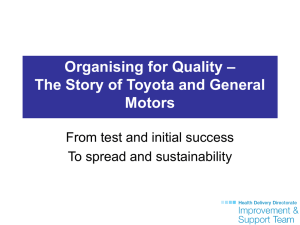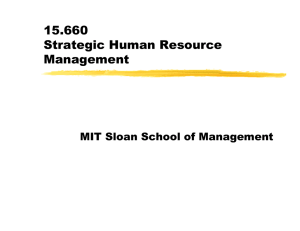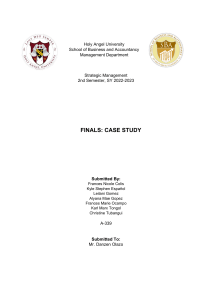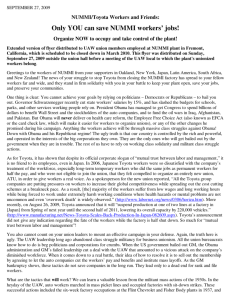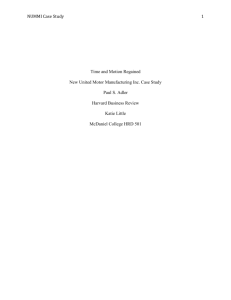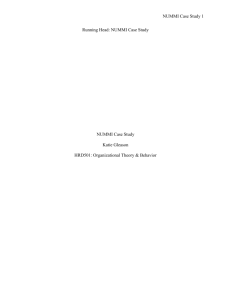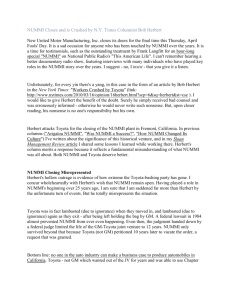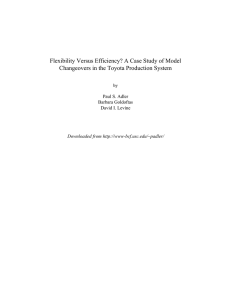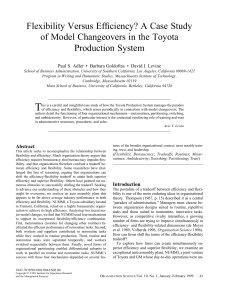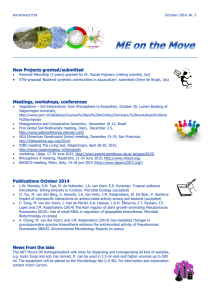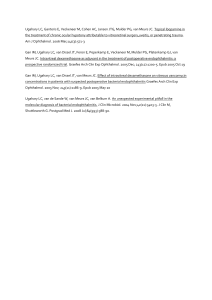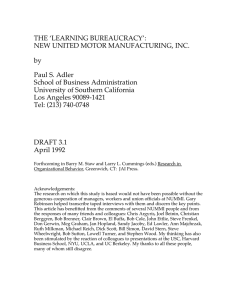Concepts of Organizational Culture and Behavior NUMMI
advertisement
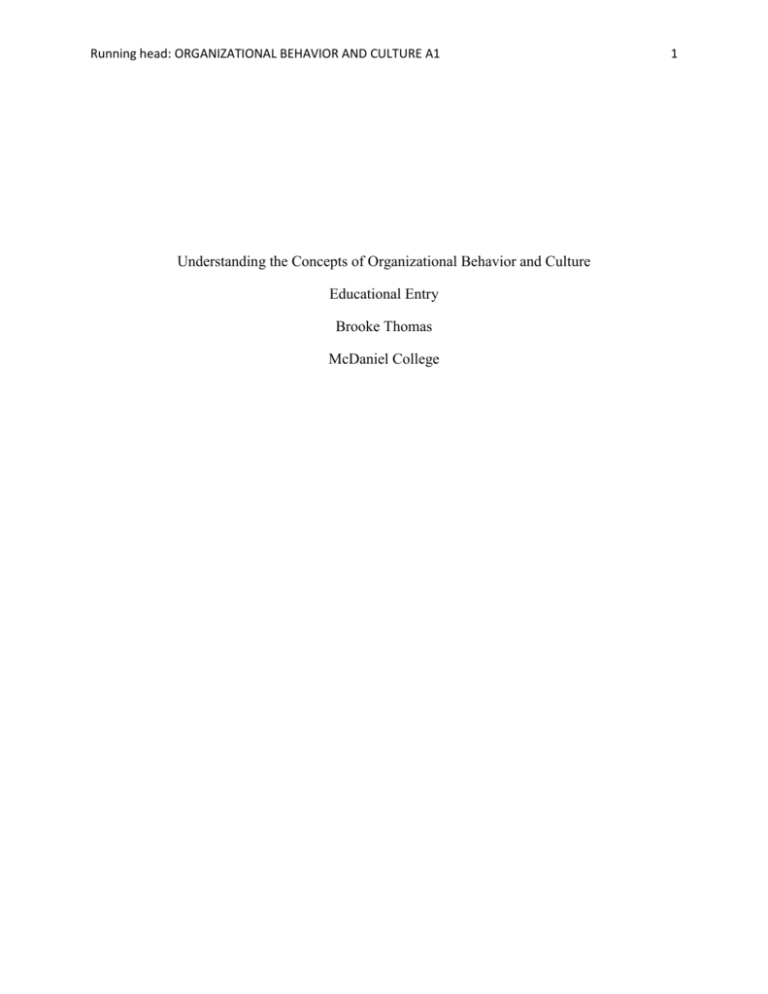
Running head: ORGANIZATIONAL BEHAVIOR AND CULTURE A1 Understanding the Concepts of Organizational Behavior and Culture Educational Entry Brooke Thomas McDaniel College 1 CONCEPTS OF ORGANIZATIONAL BEHAVIOR AND CHANGE 2 Understanding the Concepts of Organizational Behavior and Culture Organizational development can be defined as a systemwide application and transfer of behavioral science knowledge to the planned development, improvement, and reinforcement of the strategies, structures, and processes that lead to organization effectiveness (Cummings and Worley, 2008). It serves as the driving force for organizations as they seek to change the behavior and culture of employees and managers. The case study Time-and-Motion Regained described how GM-Fremont and Toyota began a joint venture, New United Motor Manufacturing, Inc. (NUMMI), in order to address the lack of productivity at the GM-Fremont manufacturing plant. The analysis of this case allowed me to fulfill the fourth objective of McDaniel’s Human Resources Development Graduate Program. This objective states that students will understand the concepts of organizational behavior and culture as well as the unique features of various organizations in order to provide interventions appropriate to an organization’s strategic plan. I am submitting the Time-and-Motion Regained case study as my artifact for this educational entry. Prior to the establishment of NUMMI, GM-Fremont suffered from many issues that would’ve eventually caused the plant to go bankrupt. The employees were plagued by alcohol and drug abuse. They frequently arrived late to work or did not report at all, and productivity was drastically decreased due to the poor work environment. The creation of NUMMI brought new hope to GM-Fremont. Toyota introduced a new production system and the Japanese philosophy of Kaizen, continuous improvement, to the GM-Fremont. CONCEPTS OF ORGANIZATIONAL BEHAVIOR AND CHANGE 3 To enforce the organizational changes needed to make NUMMI successful, employees were out of work for about two years as the new system was developed. Employees were given a “Letter of Intent” by NUMMI and the United Automobile Workers (UAW), which stated that the employees would be brought back to the plant once it reopened as an effort to build employee morale and dedication. The letter indicated that a no-lay off policy was in effect to establish job security. NUMMI felt this move would help to build a sense of loyalty and trust between company and employees. Once NUMMI opened, employees were brought back, even the troublesome ones who previously suffered from alcohol and drug problems. The organization implemented a socialization policy, which eliminated the division between employees and managers. There was centralized parking and eating areas, all employees wore the same uniform, and new hires were welcomed on-board by managers to foster an environment of togetherness and eliminate inferiority issues. These changes started to gradually transform the organization into an example of how behaviors can be changed. Another effort by NUMMI that helped to increase productivity was the application of the “Taylorist” principles. These principles incorporated a “learning-oriented” environment where the workers were more involved by providing suggestions and oversaw the criteria, evaluators, processes, and results (Adler, 1993). This approach allowed employees to be more hands-on in the development and creation of new, innovative manufacturing processes. In the past, managers did not ask employees for their input, even though it was more logical since the employees were the ones mainly impacted by the changes. The “Taylorist” principles allowed employees and managers to collaborate on ideas, created a sense of ownership for employees, and was cost effective for NUMMI. CONCEPTS OF ORGANIZATIONAL BEHAVIOR AND CHANGE 4 NUMMI became an award winning company. NUMMI was dedicated to creating relationships among all levels, and was able produce more efficient and effective employees as aresult, NUMMI showed how an organization can change the behaviors of employees regardless of the situation. According to Van Dijk and Van Dick (2009), “person-oriented resistance stems from an employee’s beliefs or concern that change has or will have a negative impact on their personal work experience” (p. 144). The authors continued to say that “it is not only the content of change but also the relationships, including communication and interaction between change leaders and employees’ experience of work and their work-based identity” (Van Dijk and Van Dick, 2009, p. 146). For NUMMI, the employees of GM-Fremont lacked morale, productivity and satisfaction. They really did not care about their jobs and it was reflected daily to managers. NUMMI could have easily replaced the workers, but instead, they decided to repair the broken relationship between managers and employees. This was done by allowing them to keep their jobs, bringing back employees who failed drug tests and giving them a second chance. Kleiner and Teller (2009) explained that “it is imperative for corporations to create an environment where employees are endowed with the ability to expand their creativity, permitted to engage in organizational decision making and encouraged to strive for perfection” (p.24). Employees gained responsibility and a sense of value from the new learning initiatives implemented by NUMMI. These initiatives allowed for employees to cross train, learn new methods and technologies and take college courses to increase their knowledge. Not only did this help employees increase productivity but they played a major role in developing new standardized processes to identify and resolve problems on with production. For GM-Fremont allowed the lack of productivity from their employees to continue for too long as a result it was harder to adapt when the market shifted. Organizations should always CONCEPTS OF ORGANIZATIONAL BEHAVIOR AND CHANGE 5 look at their strategic plan to see how changes can be made periodically. These changes will allow for organizations to improve communication, knowledge management systems and build agility. Also, organizations must look at all aspects of their business model to determine how each is functioning and what actions can be taken to allow a greater return on investment. Based on my analysis of the Time-and-Motion Regained case study, I have gained a true competence regarding understanding the concepts of organizational behavior and culture as well as the unique features of various organizations in order to provide interventions appropriate to an organization’s strategic plan. As a HR professional, you must understand how to look outside of the box in order to make progressive changes in the workplace. You have to understand the behavior and culture of an organization and how the changes you implement will affect your position and internal and external constituents. As stated in the Change Management: The HR Strategic Imperative as a Business Partner article, HR should be looked at as the “change arhitect”…HR should fulfill the roles of change champion, change facilitator, change designer, and change demonstrator (p.2). As an HR professional I know that I can successfully analyze the dynamics of an organization and lead change initiatives that will improve the strategic plan of an organization. CONCEPTS OF ORGANIZATIONAL BEHAVIOR AND CHANGE 6 References Adler (1993). Time-and-motion regained. Harvard Business Journal. 1 (1), 97-108. Cummings, T., Worley, C. (2008). Organization development and change. (9th ed.). Mason, Ohio: South-Western Cengage Learning. Gulati, R., Puranam, P., Vermeulen, F. (2010, June). Change for change’s sake. Harvard Business Review. 88 (6). 70-75. Kleiner, B., Tell, R. (2009). Organizational change can rescue industry. Industrial Management. 51 (2). 20-24. Van Dick, R., Van Dijk, R. (2009, June). Navigating organizational change: change leaders, employee resistance, and work-based identities. Journal of Change Management. 9 (2). 143-163. doi: 10.1080/1469701090289087. Change management: the hr strategic imperative as a business partner. (2007, December). HR Magazine. 1-9.
